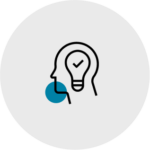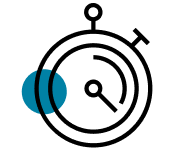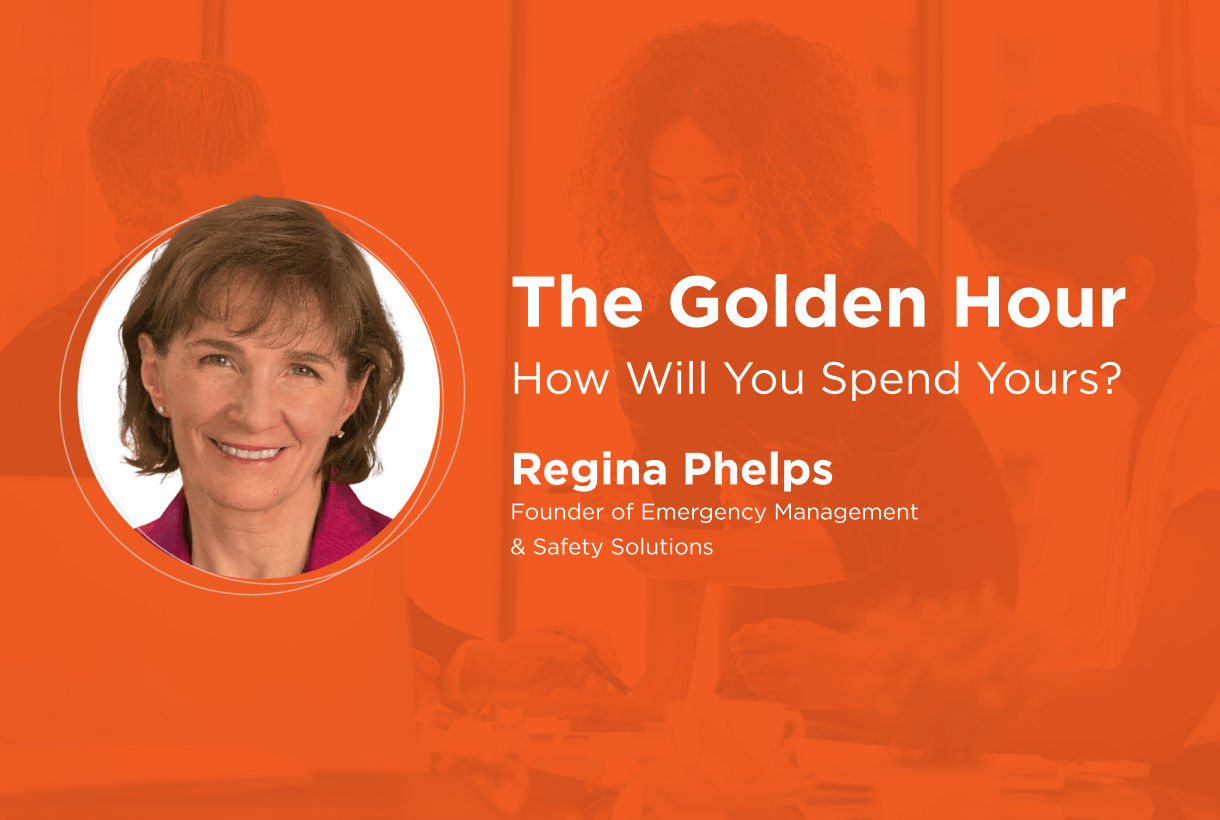Think back to the last time your organization was faced with a crisis. What happened during the first hour after the incident occurred?
Where did you get your information? How did you validate it to make sure it was accurate? How did you display it in a way that was meaningful and useful for the people making critical decisions? Did you have a preassembled team, well-versed in their roles and responsibilities, ready to handle the incident?
These were some of the pressing questions leading subject matter expert Regina Phelps, Founder and President of Emergency Management & Safety Solutions, posed during her keynote session The Golden Hour, at the OnSolve 2022 Nexus Customer Conference.

You’re probably wondering what the “Golden Hour” is.
There’s more than one meaning to the phrase, but Phelps referenced a physician who became known as the “father of trauma medicine.” He spoke of a “golden hour between life and death.” If you’re critically injured, the care you're provided during those first 60 minutes determines your fate.
The same is true in crisis management. The actions taken during the first hour after an incident – that golden hour when every second counts - lay the foundation for your response and determine if an event will be a simple (and hopefully isolated) incident versus a full-blown ongoing crisis. As part of an overall critical event management (CEM) strategy, this hour is an opportunity to lessen the impact of the event and keep your operations running.
Consider the most recent golden hour in your organization. Did you have the resources you needed for an optimized response? For most organizations, the answer is a mix of Yes and No.
Phelps identified four things organizations need to make the most of the golden hour:

Risk Intelligence

A Comprehensive Assessment Process

An Understanding
of Your Feeders

Exercises
In this blog, we’ll be focusing our attention on the risk intelligence component and how it helps organizations emerge from the golden hour after a crisis to thrive.
What Is Risk Intelligence?
Phelps defines risk intelligence as “The ability to identify, process and comprehend the critical elements of information regarding an incident.” In other words, it’s knowing what’s going on around you.
Risk intelligence facilitates this situational awareness by providing proactive and continuous monitoring of global data sources to quickly and accurately detect information about existing critical events and potential threats.
Unfortunately, many organizations are still lagging behind when it comes to this technology. Forty-four percent of organizations reported a lack of risk intelligence solutions, according to a commissioned study conducted by Forrester Consulting on behalf of OnSolve, Failing to Plan Is Planning to Fail.
In addition, organizations reported struggling with control-center-level visibility capabilities that deliver situational awareness. Specifically, they struggled most with risk intelligence that enables them to quickly identify and understand the scope of an event as it occurs, according to the Forrester study.

How Can Risk Intelligence Help You Maximize the Golden Hour?
In our global economy, people who are widely geographically distributed can all be affected by a critical event, even when its immediate impact zone initially seems limited to a particular locality. Consider the following international example:
A typhoon decimates a manufacturing plant in Southeast Asia, stopping production of a critical component required by your primary facility in the U.S. The onsite plant manager’s UK family hears about the hurricane on the BBC and immediately contacts your organization to find out if their loved one is safe. At the same time, operations and delivery of the final product to customers on multiple continents will be delayed while the plant recovers. Meanwhile, local news media are implying the plant may not have fully complied with safety regulations, calling your organization’s reputation into question.
This ripple effect necessitates supportive technology to deliver accurate, up-to-date information so you can act swiftly and appropriately during the golden hour. In the typhoon example above, risk intelligence technology would have gathered reliable information prior to the typhoon, so the organization could have taken proactive measures to protect and notify the manufacturing plant and the employees working there.
As the event unfolded, risk intelligence technology would continue to monitor the situation, so different business units could be notified and activate backup plans to deliver products and services. Business leaders would even have been able to add a new risk intelligence filter to monitor the company’s brand reputation during and after the incident, enabling corporate communications to deliver effective messaging to protect the company’s image.
Regardless of the critical event, risk intelligence answers such questions as:
- Who is impacted?
- What is impacted?
- Could something else impact us at the same time?
- Is the situation still unfolding?
Armed with this information, organizations can make faster and smarter decisions to protect employees, mitigate damage to property and technology assets, and minimize the disruption to operations.
4 Steps to Effectively Utilize Risk Intelligence During the Golden Hour
To utilize the golden hour, security leaders must improve overall situational awareness. It’s a tall order, but when utilized effectively AI-powered and analyst-vetted risk intelligence offers unique benefits. Use these four steps to make it happen:

1. Observe
Gather and validate your information. The complications of today’s threat landscape can make data collection feel like you’re drinking from a firehose. Human-driven analysis simply isn’t enough. AI-powered and analyst-vetted risk intelligence can comb through thousands of sources, including government, weather and geological services, local and international press, and social media. The information then gets validated to ensure only confirmed facts from credible authorities are provided. AI-powered risk intelligence does this in a fraction of the time it would take human analysts alone.

2. Orient
Once you have the information, risk intelligence correlates it to your people, places and property. It’s about asking who, what, when, where and how a critical event could impact them. Between internal vs. external and formal vs. informal sources, the threat landscape is an aggregate of a vast array of data. Risk intelligence technology makes complex information more comprehensible – and therefore more actionable – by laying it out in a visual representation. Thanks to AI, the noise of irrelevant data gets filtered out so you can deliver the right information to the right people at the right time. This gives business continuity managers the opportunity to focus their resources on protective measures in time to make a difference.

3. Decide Priorities
This can be the most difficult task, because in the moment everything feels like a priority. The analysis risk intelligence provides is key to making those first few decisions on your best immediate course of action. It’s one thing to know life-saving measures should always be first. It’s another to execute in the moment, when a crisis is unfolding. Alarms and flashing lights around you may be distracting, but AI is immune to such external stimuli. It filters out the noise from the data coming in, providing a trustworthy source for creating a hierarchy of response actions, so you can mitigate the damages faster.

4. Act Fast
The circumstances of a disaster are often fluid, especially within the first hour. You may receive one update, only to have it negated a few moments later by another. You cannot afford to be paralyzed by indecision. With real-time intelligence, you can stay on top of developments, and therein lies the key to better decision-making. The objective is to act in time to minimize damages. This is especially important when facing a confluence of events like a fire evacuation in an area already dealing with multiple road closures. Risk intelligence can let you know as soon as routes are clear, so no time is wasted due to anticipatory anxiety or unnecessary waiting.
In the chaos of a crisis, a reliable risk intelligence solution delivers fast, accurate and relevant information so you can make rapid, informed decisions when every second counts.


